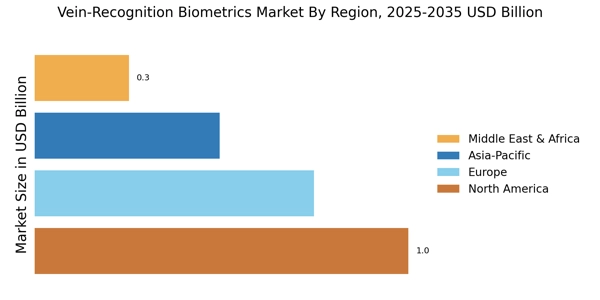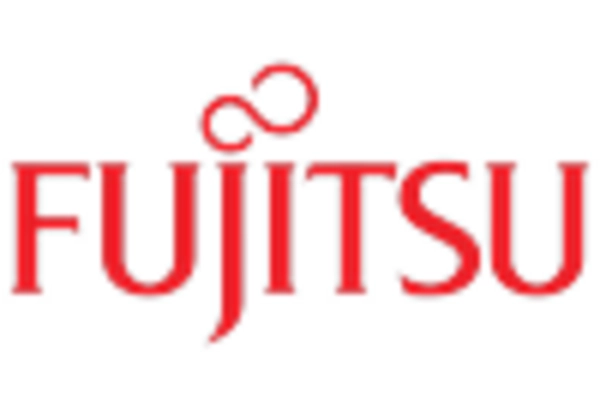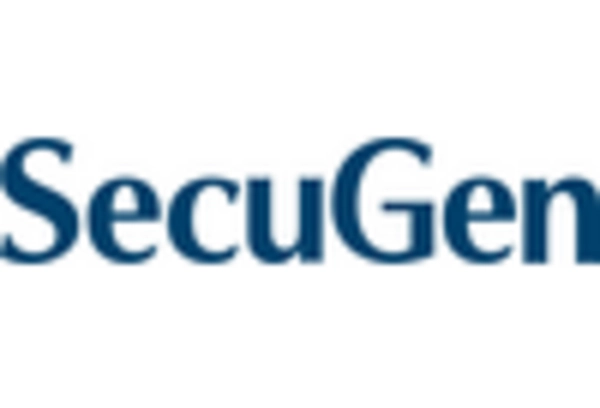Integration with Smart Devices
The integration of vein-recognition biometrics with smart devices is emerging as a significant driver for the Vein-Recognition Biometrics Market. As the Internet of Things (IoT) continues to expand, the demand for seamless and secure authentication methods is growing. Vein recognition technology can be embedded in various smart devices, including smartphones, wearables, and access control systems, providing users with a convenient and secure way to authenticate their identities. The market for IoT devices is projected to reach USD 1 trillion by 2025, and the incorporation of biometric solutions is likely to enhance the functionality and security of these devices. This trend suggests that the synergy between vein-recognition technology and smart devices will play a crucial role in shaping the future of the biometrics market.
Advancements in Imaging Technology
Technological advancements in imaging technology are significantly influencing the Vein-Recognition Biometrics Market. Innovations in near-infrared imaging and pattern recognition algorithms have enhanced the accuracy and efficiency of vein recognition systems. These advancements allow for faster processing times and improved user experience, which are essential for widespread adoption. The market for imaging technology in biometrics is expected to grow substantially, with projections indicating a compound annual growth rate of over 20% in the coming years. As imaging technology continues to evolve, it is likely to drive the development of more sophisticated vein-recognition systems, making them more appealing to businesses seeking reliable biometric solutions.
Regulatory Compliance and Standards
Regulatory compliance and the establishment of standards are driving factors in the Vein-Recognition Biometrics Market. Governments and regulatory bodies are increasingly mandating the use of biometric systems for identity verification in various sectors, including finance and transportation. Compliance with these regulations not only enhances security but also fosters consumer trust. The implementation of stringent data protection laws has further accelerated the adoption of biometric technologies, as organizations seek to meet legal requirements. As the regulatory landscape continues to evolve, it is anticipated that the demand for vein-recognition biometrics will increase, as businesses strive to align with compliance standards while enhancing their security measures.
Rising Adoption in Healthcare Sector
The healthcare sector's increasing adoption of vein-recognition biometrics is a notable driver for the Vein-Recognition Biometrics Market. Hospitals and clinics are increasingly implementing biometric systems to enhance patient identification and streamline access to medical records. This technology minimizes the risk of identity fraud and ensures that patients receive the correct treatment. Recent studies indicate that the healthcare biometrics market is expected to grow at a rate of approximately 25% annually, with vein recognition being a preferred choice due to its non-intrusive nature and high accuracy. As healthcare providers continue to prioritize patient safety and data security, the demand for vein-recognition systems is likely to rise.
Growing Demand for Secure Authentication
The increasing need for secure authentication methods is a primary driver for the Vein-Recognition Biometrics Market. As organizations seek to protect sensitive data and ensure user privacy, traditional authentication methods such as passwords are becoming inadequate. The rise in cyber threats and data breaches has prompted businesses to adopt more reliable biometric solutions. According to recent estimates, the biometrics market is projected to reach USD 60 billion by 2025, with vein recognition technology playing a crucial role in this growth. This technology offers a unique advantage due to its difficulty to forge, making it an attractive option for sectors like banking, healthcare, and government. Consequently, the demand for secure authentication is likely to propel the adoption of vein-recognition systems across various industries.

















Leave a Comment